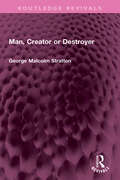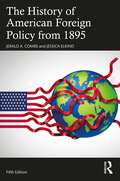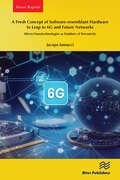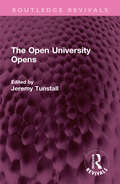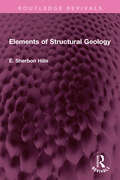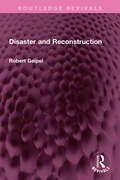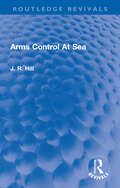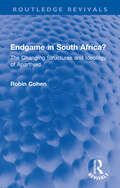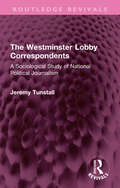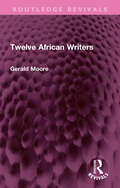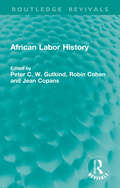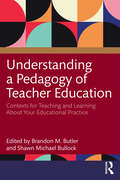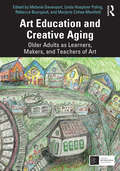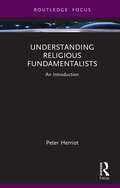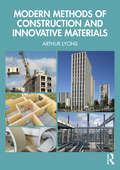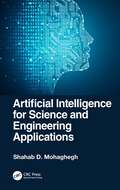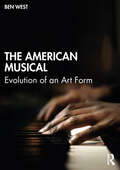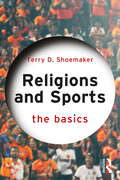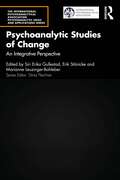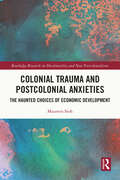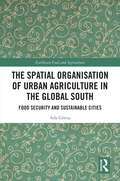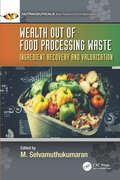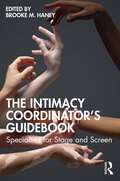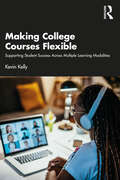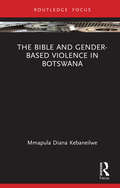- Table View
- List View
Man, Creator or Destroyer (Routledge Revivals)
by George Malcolm StrattonFirst published in 1952, Man, Creator or Destroyer makes clear that mankind is preeminent both as a creator and as a destroyer. And we are doomed unless creative man can master destructive man. But how gain this mystery? How strengthen the one and weaken the other? This and other vital questions are answered clearly for the general reader interested in creative work, from art and science to crime-prevention and international statecraft. The first part is concerned with man’s creative power which distinguishes him from all else on earth and suggests that man is much more than a machine or an animal. In the second part attention moves to man’s destructive power and studies his inclination to obstruct and shatter his own constructive work. The book concludes with an examination of the ways in which the creative power can gain the mastery.
The History of American Foreign Policy from 1895 (xx xx)
by Jerald A. Combs Jessica ElkindNow in its fifth edition, this volume offers a clear, concise, and nuanced history of U.S. foreign relations since the Spanish–American War and places that narrative within the context of the most influential historiographical trends and debates.The History of American Foreign Policy from 1895 includes both revised and new sections that incorporate insights from recent scholarship on the United States in the world. These sections devote more attention to the international framework as well as the domestic constraints under which American foreign policymakers operated. This edition also emphasizes the role of non-state actors such as missionaries, aid workers, activists, and business leaders in shaping policies and contributing to international relations. As a result, the text considers a broader and more diverse range of people and voices than many other histories of U.S. foreign policy. Expanded final chapters bring the story of U.S. foreign relations to the present and explore some of the contemporary challenges facing American and global leaders, including terrorism, the effects of climate change, China’s increasing influence, and globalization. Updated controversial issues sections and suggestions for further reading at the end of each chapter reflect important contributions from new studies.This engaging text is an invaluable resource for students interested in the history of American foreign policy and international relations.
A Fresh Concept of Software-resemblant Hardware to Leap to 6G and Future Networks: Micro/Nanotechnologies as Enablers of Pervasivity
by Jacopo IannacciFor a decade, with the uptake of 4G, we have become accustomed to the relentless increase in data and services on the move. The deployment of 5G is advancing crucial key performance indicators (KPIs), along with quality of service (QoS). Setting the horizon to 2030 and later, 6G will take the KPIs to numbers 100–1000 times better than 5G. Yet, the actual disruption of 6G and future networks (FN) will take place following other unprecedented paths.Artificial intelligence (AI) will be exploited in a threadlike fashion, at any level of the network physical infrastructure. This will introduce, to date unknown features, like self-sustaining, self-evolution and high-resilience of small portions of the infrastructure, pioneering the concept of a network of networks. Each segment of the infrastructure will bear a high degree of independence, while working at the same time as a whole, in full orchestration with the rest of the network.Given such a scenario, this book claims that the established and currently in use paradigms for the design and development of hardware–software (HW–SW) systems, are not appropriate to address the challenges of 6G and, further ahead, of FN. In response, unprecedented design approaches are suggested, relying on a fresh reinterpretation of the standard concept of HW, with specific attention to the network edge and edge intelligence (EI).This work develops some conceptual tools that may help address the technical challenges resulting from the intricate scenario sketched above. Within the mentioned HW reconceptualization, a pivotal role is forecasted for microtechnologies and nanotechnologies, intended with a broad meaning, which embraces, among others, devices, systems (MEMS/NEMS) and materials.
The Open University Opens (Routledge Revivals)
by Jeremy TunstallStill going strong today, The Open University, Britain’s national correspondence – TV – radio University, excited much controversy when it first opened and in 1973 awarded its first degrees. With its adult, part-time students, its freedom from formal entrance qualifications, it deliberately questioned many orthodoxies of higher education at the time. Yet the OU differed so much from other universities that few outsiders grasped quite how complex, quite how revolutionary, quite how downright infuriating the OU was, or could be.Originally published in 1974, this book gives a first-hand account of what the OU was about and what it felt like to be an OU student or lecturer. The articles in the collection – edited by Jeremy Tunstall, himself on the OU staff – include contributions from outside observers, from OU staff, and from OU students. This is an unofficial yet informed and lively account of what it felt like in 1974, and what it felt like in the early days, to be part of a project so controversial and progressive.
Elements of Structural Geology (Routledge Revivals)
by E. Sherbon HillsOriginally published in 1963, this classic textbook was revised fully for the 1972 edition. The author presents a comprehensive account of all topics falling within the domain of structural geology in his characteristically objective, scientific and logical manner. The book pays particular attention to definitions and the origin of terms. Geology is a global science and this book used examples and ideas from work in many countries. The book is comprehensive in scope, dealing not only with secondary structures and tectonics, but also with primary structures of secondary and igneous rocks. This was the first textbook to deal with rock material as two-phase systems rather than as solids and this approach is continued in this reissued edition by analysis of concepts such as ocean-floor spreading and plate tectonics
Disaster and Reconstruction (Routledge Revivals)
by R GeipelOriginally published in 1982 and based on empirical research into the aftermath of the Friuli earthquake in Italy, the book reflects the perspective gained over a period of four years on the event itself and the subsequent response of the local population and national government. Unique insights were gained through one of the largest questionnaire surveys ever undertaken in a disaster situation and important questions are posed concerning the policies of reconstruction. Is a disaster ‘the great equalizer’ and does regional society emerge from it with redistributed power relationships, or are established structures reinforced? Who gets hurt and who benefits? What effects do poverty, regional remoteness from central government and the ethnic and cultural dimensions have on the situation? As a substantial treatment of a major catastrophe in all its aspects, this book will be of interest to students and researchers concerned with the impact of and response to natural hazards. It is based on a unique event, but the findings it reveals are relevant to all major catastrophes.
Arms Control At Sea (Routledge Revivals)
by J Richard HillOriginally published in 1989, this book reviews the history of maritime control measures from before the First World War and provides a critical examination of both the objectives of maritime power and the concepts of disarmament, peace zones, parity, verifiability and peaceful co-existence. It argues that the objectives or maritime power are not necessarily incompatible with international security and that strategic deterrence can contribute to improved security. Limitation measures, it is argued, can in some cases be double-edged, endangering other security fields and having a destabilizing effect. The book stresses the need for non-absolute solutions in order to achieve a reasonable level of security and makes proposals for both structural and confidence-building measures along those lines
Endgame in South Africa?: The Changing Structures and Ideology of Apartheid (Routledge Revivals)
by Robin CohenThe white monopoly of political power; the attempt to make race coincide with space; the regulation of the labour supply; the maintenance of social control. Originally published in 1986 and now reissued with a new preface by Robin Cohen, this book acknowledges that the above are the four pillars of apartheid and asks if white political power were dislodged whether the other three pillarswould crumble. This is a concise book which evaluated social and political change in South Africa at a key moment in the nation’s history and which assesses the limits and possibilities of ideological adaptation
The Westminster Lobby Correspondents: A Sociological Study of National Political Journalism (Routledge Revivals)
by Jeremy TunstallThe Westminster Lobby correspondents have a special place in both the politics and the mass media of Britain. These journalists dominate the behind-the-scenes reporting of British national politics. In this book, originally published in 1970, Jeremy Tunstall presents the first systematic social science study of the uniquely British phenomenon of Lobby correspondents.The study includes data collected from interviews with the national Lobby correspondents, who also completed lengthy questionnaires. It contains evidence of their careers, political opinions, pay, working conditions, relationships with their employing news organization and political news sources, and on the way in which the correspondents both compete with, and exchange information with, each other. As well as this fascinating empirical data, the book offers an important contribution to the sociology of politics and the mass media, and to the study of ‘organizational intelligence’ and the sociology of occupations.There had long centred upon the Lobby correspondents many myths and misconceptions, which Jeremy Tunstall effectively demolishes. (The so-called ‘Lobby rules’ were here published for the first time.) Other real dilemmas are, however, revealed: the competing demands of publicity and secrecy; the dilemmas of British politics in which basic principles – such as Parliamentary supremacy and Cabinet secrecy – are daily breached, not only by the correspondents, but also by leading politicians; and the problems of a system of political communication whose obsession with daily news values is so similar to official and academic contributions. With media and politics still very much linked today, this reissue can be read and enjoyed in its historical context.
Twelve African Writers (Routledge Revivals)
by Gerald MooreOriginally published in 1980, this book introduces the student to twelve of the most exciting and significant African authors of the 20th Century, whose work represents Anglophone and Francophone writing (with translation) drawn from West, East and Southern Africa. Twelve African Writers was a revised, updated and extended edition of the pioneering Seven African Writers which did so much to make students aware of African literature. The book also contains an extensive bibliography of the works not just of the selected writers, but other important African authors and recommendations of further critical works.
African Labor History (Routledge Revivals)
by Peter C.W. Gutkind Robin Cohen Jean CopansOriginally published in 1978, this book was distinctive in translating the work of French labour specialists and includes chapters on Nigeria, South Africa, Senegal, Kenya, Tanganyika, Madagascar and Botswana. Although all the papers are set in historically specific events, some of the larger issues receive further treatment. These concern the reality of the existence of an African working class and its class identity and consciousness. Each contributor adds to the debate by means of demonstrating how African workers have responded to their work situation, to deprivation and exploitation, and to the political authority of the colonial or neocolonial state
Understanding a Pedagogy of Teacher Education: Contexts for Teaching and Learning About Your Educational Practice
by Brandon M. Butler Shawn Michael BullockProviding readers with insights and examples of how teacher educators learn and teach a pedagogy of teacher education (PTE), Butler and Bullock organize a wholistic and practical resource for the next generation of teacher educators. Expanding on the highly referenced scholarship of John Loughran and Tom Russell, Understanding a Pedagogy of Teacher Education explores the learning of PTE through individual and collaborative endeavors, and large-scale institutional and cross-national initiatives. Contributors highlight their experiences teaching PTE in formal learning spaces, in international workshop settings, and on the program-wide scale in order to uncover how they came to understand PTE and enact it effectively. Each chapter connects broad strokes concepts of PTE to well-defined teacher education fields, such as social justice, literacy, early childhood education, and communities of practice. Blending well- established theory with contemporary examples, this book is a great tool for teacher education faculty, doctoral students, and those interested in improving their PTE or supporting others in their PTE learning.
Art Education and Creative Aging: Older Adults as Learners, Makers, and Teachers of Art
by Melanie Davenport Linda Hoeptner Poling Rébecca Bourgault Marjorie Cohee ManifoldThis text explores how art education can meaningfully address the needs of older adults as learners, makers, and teachers of art in formal and informal settings. It combines perspectives of museum educators, teacher preparation professors, art therapists, teaching artists, and older artists on what is meant by Creative Aging and the ways art education can support the health and well-being of this population. Most importantly, the book discusses what the field of art education can gain from older adult learners and creators.Chapters are organized into five sections: Creatively Aging, Meeting Older Adults’ Unique Needs, Intergenerational Art Education, Engaging Older Adults With Artworks and Objects, and In Our Own Voices: Older Adults as Learners, Makers, and Teachers. Within each section, contributors investigate themes critical to art education within aging populations such as memory loss, disability, coping with life transitions, lifelong learning, intergenerational relationships, and personal narrative. The final section focuses on accounts from older adult artists/educators, offering insights and proposing new directions for growing older creatively.Though ideal for art education faculty and students in graduate and undergraduate settings, as well as art education scholars and those teaching in multigenerational programs within community settings, this book is an expansive resource for any artist, student, or scholar interested in the links among health, well-being, and arts participation for older adults.
Understanding Religious Fundamentalists: An Introduction (Routledge Focus on Religion)
by Peter HerriotThis book introduces the prominent role that fundamentalists play in religious, cultural, and political arenas.It begins by investigating religious fundamentalist groups and their psychological motivations for this counter-cultural adherence. Their extremely varied actions, argues the author, are based on two fundamental beliefs: that God speaks to them personally through his Word; and that they are involved in a cosmic war between God and Satan.. Subsequent chapters explore how fundamentalisms meet universal psychological needs for meaning, identity, agency, and self-esteem. Moving from individual psychology to social context, the latter half of the book explores how fundamentalist movements derive and exercise their authority and how leaders may strategise to appeal to external societies. The closing chapters seek to place the growth of fundamentalisms and their continued popularity in the social context of modernity and populism.With engaging discussion questions and suggestions for further reading, this book is ideal for students of social science and religion, as well as readers interested in the psychological roots of fundamentalism.
Modern Methods of Construction and Innovative Materials
by Arthur LyonsThis new textbook has two main themes. The first is Modern Methods of Construction (MMC) which is the off-site manufacture of a wide spectrum of products, ranging from whole buildings to be transported onto site, down to smaller units or components for site integration. The second theme describes the innovation and progress towards carbon zero by the major generators of CO2 in the construction industry – namely cement, steel and masonry.The first section of the book describes and illustrates with photographs, the major forms of Modern Methods of Construction. These include fully completed 3D units, panelised systems, pods, sub-assemblies and on-site MMC. The section on Innovative Materials then describes a wide range of construction products which are entering into the built environment sector. Some new entrants are variants on well-established construction materials such as steel and concrete. Materials such as these will remain major construction materials for the foreseeable future, but their composition and manufacturing processes will inevitably have to change. Timber also will remain a major construction material, but sustainable sourcing is key and its utilisation as cross-lamination timber (CLT) or as modified timber is rapidly developing. As a result, students and practitioners must familiarise themselves with these materials, their composition, and various uses.The book goes on to describe variants of other traditional building products, such as glass, plastic and insulation, which are undergoing major developments leading towards enhanced environmental sustainability, as well as many emergent materials, some of which are likely to be significant in future. Modern Methods of Construction and Innovative Materials is the only book combining these important elements of the future of the industry in an easy-to-read guide for students and new practitioners. It is essential reading for anyone studying and working in the built environment, be they architects, construction managers, surveyors or engineers.
Artificial Intelligence for Science and Engineering Applications
by Shahab D. MohagheghArtificial Intelligence (AI) is defined as the simulation of human intelligence through the mimicking of the human brain for analysis, modeling, and decision‑making. Science and engineering problem solving requires modeling of physical phenomena, and humans approach the solution of scientific and engineering problems differently from other problems. Artificial Intelligence for Science and Engineering Applications addresses the unique differences in how AI should be developed and used in science and engineering. Through the inclusion of definitions and detailed examples, this book describes the actual and realistic requirements as well as what characteristics must be avoided for correct and successful science and engineering applications of AI.This book:• Offers a brief history of AI and covers science and engineering applications• Explores the modeling of physical phenomena using AI• Discusses explainable AI (XAI) applications• Covers the ethics of AI in science and engineering• Features real‑world case studiesOffering a probing view into the unique nature of scientific and engineering exploration, this book will be of interest to generalists and experts looking to expand their understanding of how AI can better tackle and advance technology and developments in scientific and engineering disciplines.
The American Musical: Evolution of an Art Form
by Ben WestThe American Musical is a comprehensive history of an American art form. It delivers a detailed and definitive portrait of the American musical’s artistic evolution over the course of seven distinct, newly defined eras, with a unique perspective gleaned from research at more than twenty different archives across the United States.Individual in both its approach and coverage, The American Musical traces the form’s creative journey from its 19th century beginnings, through its 20th century maturation, and to the turn of the 21st century, shedding new light on a myriad of authors, directors, and craftspeople who worked on Broadway and beyond. This book actively addresses the form’s often overlooked female and African-American artists, provides an in-depth accounting of such outside influences as minstrelsy, vaudeville, nightclubs, and burlesque, and explores the dynamic relationship between the form and the consciousness of its country.The American Musical is a fascinating and insightful read for students, artists, and afficionados of the American musical, and anyone with an interest in this singular form of entertainment.
Religions and Sports: The Basics (The Basics)
by Terry D. ShoemakerReligions and Sports: The Basics introduces the many connections and interactions between religions and sporting activities.Readers will gain a foundational understanding of how to approach religions and sports analytically, theoretically, and methodologically. The book uses multiple relational frameworks to examine probing discussions around religious expressions in sports, the social connections of religions and sports, the mirroring of sport and religious devotion, and the discourse between religious ideas and leaders and professional athletes. Supplemented with numerous case studies and engaging exercises, it guides students through approaching research inquiries within the intersection of religion and sport for the first time.With lively discussion on contemporary sports including skateboarding and pickleball, it is a must-read for all students of Religions and Sports and Religion and Popular Culture, in addition to sports fans more broadly.
Psychoanalytic Studies of Change: An Integrative Perspective (The International Psychoanalytical Association Psychoanalytic Ideas and Applications Series)
by Erik Stänicke Marianne Leuzinger-BohleberPsychoanalytic Studies of Change presents recent studies of the process and outcome of psychoanalytic therapy with an integrative perspective.A recurrent challenge in the discussion of therapeutic outcome is the gap between empirical, quantitative studies, reporting results on a group level, and the clinician’s interest in complex mechanisms of change presupposing microanalysis of dynamic interaction processes. This book bridges that gap via dynamic contributions from a variety of authors. Quantitative and qualitative studies are connected, epistemological and conceptual research is emphasized as specific domains, and in-depth clinical case studies are highlighted. The book comprises several new contributions to epistemology and conceptual research, as well as chapters discussing the challenge of combining qualitative and quantitative methods in studying process and outcome.Psychoanalytic Studies of Change will not only meet a need specifically within psychoanalysis for up-to-date research but also provide an overview of the latest empirical research on psychoanalysis for a broader clinical and academic group of readers. It will appeal to psychoanalysts in practice and in training.
Colonial Trauma and Postcolonial Anxieties: The Haunted Choices of Economic Development (Routledge Research on Decoloniality and New Postcolonialisms)
by Maureen SiohColonial Trauma and Postcolonial Anxieties argues that economic decisions reflect unconscious anxieties about survival and dignity experienced in a cycle of repeat trauma tracing back to the original trauma of loss in colonialism.Readers will understand how emerging economies evaluate the costs and benefits of key economic policies in the postcolonial era using a psychoanalytical framework.While there are psychoanalytic studies of the economy and finance from a western perspective, there have been no sustained psychoanalytic studies from the perspective of East Asian economies, the fastest growing in the world. Scholars will also find the methodology combining archival research with and field studies, including rare interviews with senior decision-makers useful in their own research since it is rare to find studies of social theory that are empirically rich.This book will be of interest to policymakers and scholars of political economy, international development, human geography, postcolonial studies, psychoanalysis, and area studies (Southeast and East Asia). The book can also be used as a text for graduate and upper level university courses.
The Spatial Organisation of Urban Agriculture in the Global South: Food Security and Sustainable Cities (Earthscan Food and Agriculture)
by Ada GórnaThis book examines the role and position of urban agriculture in the spatial and functional structure of cities in the Global South.In the face of dynamic urbanisation and negative consequences of climate change, one of the key challenges is not only how to provide food for the ever-growing urban population but also how to achieve urban sustainability and simultaneously reduce the negative impact of cities on the natural environment. These problems are particularly urgent in the metropolises of the Global South that are experiencing the greatest population growth while struggling with increasing social inequalities and the resulting uneven distribution of resources. Examining the role that urban agriculture can play in addressing these challenges, this book draws on three case study cities: Havana, Singapore and Kigali. The case studies, differing in socio-economic, spatial, political and environmental terms, exemplify diverse characteristics of urban agriculture in different geographical conditions. Drawing on fieldwork conducted in each city, the book also provides a unique perspective on the constraints in the development of urban agriculture and the use of its full potential for urban sustainability.This book will appeal to students and scholars, as well as decision makers, interested in the issues of urban sustainability, food security, spatial development and alternative food systems.
Wealth out of Food Processing Waste: Ingredient Recovery and Valorization (Nutraceuticals)
by M. SelvamuthukumaranHigh amounts of waste are generated daily in various food processing industries inclusing seed, pomace, pit, peel, germ, husk, broken pulses, sludge, skin, bones, blood, feathers, wash water, and spent residue, among others. Several tons of generated waste can be effectively used to manufacture or recover such value-added by-products as fibers, antioxidants, proteins, vitamins and minerals, biofilms, fertilizers, and animal feed. While food processing- generated waste may lead to health and environmental hazards, it is critical to identify proper protocols to recover valuable ingredients from waste, thereby creating wealth in the society.Wealth out of Food Processing Waste identifies and describes the proper protocols to recover valuable ingredients from waste, thereby creating wealth in society. The effective utilization of waste can generate income for the entrepreneur, lead to more employment for society, enhance fertility of soil, reduce environmental pollution, conserve resources, and help augment national economies to a greater extent.Key Features: Provides in-depth knowledge about conversion of waste derived from various food processing industries into various value-added products Highlights the extraction of antioxidants and functional food ingredients from industrial food waste Presents current and emerging trends using biotechnological approaches for conversion of waste into various value-added products This book provides food industry personnel, scientists, food engineers, biotechnologists, research scholars, and students with strategies for effective utilization of waste from various food processing industries.
The Intimacy Coordinator's Guidebook: Specialties for Stage and Screen
by Brooke M. HaneyThe Intimacy Coordinator's Guidebook: Specialties for Stage and Screen explores the role of the intimacy choreographer with an in-depth look at specializations that exist within the profession.With contributions by over 30 industry professionals, this book aims to bring awareness to a wide range of needs a project may have and how intimacy professionals use their cultural competency specialists in practice to create the most compelling storytelling. In Part One, the book addresses the scope of practice of an intimacy professional by discussing competency, finding your lens and tangential fields in the industry like fight directors, mental health coordinators and cultural competency specialists. Part Two covers specialties like working with minors, prosthetics, intimacy and disability, staging queer intimacy, working with fat actors, Black American intimacy, dance, working on scenes of trauma, sexual violence and non-consent, and BDSM. Between each chapter is a conversation with an actor, director or producer on their experiences working with an intimacy coordinator. In Part Three, the book looks at what it means to be qualified and intimacy professionals' hopes for the future of the industry.The Intimacy Coordinator's Guidebook is an invaluable resource for directors and producers looking to hire an intimacy professional, as well as in-depth study for those who are training or practicing in the field of intimacy for performance.
Making College Courses Flexible: Supporting Student Success Across Multiple Learning Modalities
by Kevin KellyAddressing students’ increasing demand for flexibility in how they complete college courses, this book prepares practitioners to create equivalent learning experiences for students in the classroom and those learning from home, synchronously or asynchronously. Combining evidence-based strategies and implementation stories shared by veteran practitioners, Kevin Kelly has created a guide for educators who want to offer a more flexible and equitable path to learner success. Chapters address emerging challenges related to teaching, learning, and managing technology, and give recommendations for supporting students in courses that combine two or more participation modalities. Written for busy professionals, readers will be able to quickly identify where to focus their attention and how to put these ideas into practice. Filled with impactful teaching techniques, lessons learned, and immediately applicable exercises, this resource is a powerful tool for creating course experiences that support every student.
The Bible and Gender-based Violence in Botswana (ISSN)
by Mmapula Diana KebaneilweThe Bible and Gender-based Violence in Botswana foregrounds the rampancy of gender-based violence against women and girls in biblical texts and how it resonates with gender-based violence (GBV) in the author’s contemporary context of Botswana.The volume reads selected texts from the Bible alongside newspaper reports of GBV against women and girls in Botswana to show that while the Bible is taken as an authoritative text within the Botswana context, it is riddled with GBV against female persons. It asserts that by acknowledging and naming GBV in biblical texts and not concealing, ignoring, or spiritualizing it, contemporary communities of faith will be able to confront the problem in these contexts. By so doing, the book argues, the Bible will become a resource for positive transformation rather than a tool for supporting gender injustice.The book appeals to everyone willing to see positive change in regard to gender in/equality and is intended for a wide readership including researchers, postgraduates, church and other representatives of religious institutions, and upper-level undergraduates.
